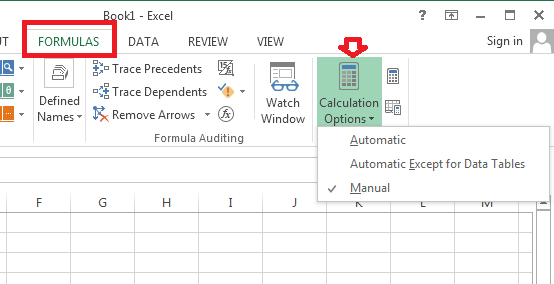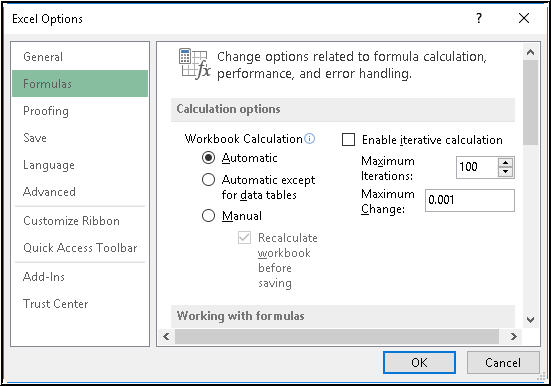- Excel Manual Calculation Shortcut
- Manual Calculation Excel 2013 Mac Download
- Excel Defaults To Manual Calculation
Formulas are equations that perform calculations on values in your sheet. All formulas begin with an equal sign (=). You can create a simple formula by using constant and calculation operator. For example, the formula =5+2*3, multiplies two numbers and then adds a number to the result.
The Calculation Option keeps switching from Auto to Manual and since we don't see it, we have bogus data. This doesn't happen all the time so i'm guessing it is not a setting but possibly a problem with the install.
When you want to refer to variables instead of constants, you can use cell values, for example, =A1+A2. If you are working with long columns of data, or data that is located in different parts of a sheet or on another sheet, you can use a range —for example, =SUM(A1:A100)/SUM(B1:B100), which represents the division of the sum of the first hundred numbers in column A by the sum of those numbers in column B. When your formula refers to other cells, any time that you change the data in any of the cells Excel recalculates the results automatically.
You can also create a formula by using a function, a predefined formula that simplifies entering calculations.
- VBA Calculate Application Method – Instructions. Step 1: Open any existing Excel Application. Step 2: Press Alt+F11 – This will open the VBA Editor or Open it from Developer Tab. Step 3: Insert a code module from then insert menu. Step 4: Copy the above code and paste in the code module which have inserted in the above step.
- I have been sent an Excel (2007) spreadsheet produced on a PC in Windows. This spreadsheet has macros with multiple inputs. Once the inputs are entered, you click a calculation function and the spreadsheet is to perform all the calculations in the macros. This works on PCs but doesn't in my version of Office for Mac Excel 2011.
Equal signs start all formulas.
Constants, such as numbers or text values, can be entered directly into a formula.
Operators specify the kind of calculation that the formula performs. For example, the ^ (caret) operator raises a number to a power, and the * (asterisk) operator multiplies numbers.
Functions are premade formulas that can be used alone, or as part of a longer formula. Each function has a specific argument syntax.
Cell values let you to reference an Excel cell, instead of the specific value inside the cell so that the contents of the cell can change without the function that refers to the cell having to change.
Excel Manual Calculation Shortcut
Enter a formula that refers to values in other cells
In a sheet that contains columns of numbers, click the cell where you want the formula results to appear.
Type an equal sign =
Click the first cell that you want to include in your calculation.
Type an operator. An operator is the kind of calculation that the formula performs. For example, the * (asterisk) operator multiplies numbers. In this example, use the / (forward slash) operator to divide. At this point your formula should look like this:
Click the next cell that you want to include in your calculation. Now your formula should look like this:
Press RETURN.
The result of the calculation appears in the cell.
Tip: To quickly apply a formula to the next cells down in the column, double-click the fill handle on the first cell that contains the formula.
Enter a formula that contains a function
In a sheet that contains a range of numbers, click the empty cell where you want the formula results to appear.
Type an equal sign and a function, for example =MIN. MIN finds the smallest number in a range of cells.
Type an opening parenthesis, select the range of cells that you want to include in the formula, and then type a closing parenthesis.
Press RETURN.
In our example, the MIN function returns 11, the smallest number in cells A1 through C4.
Tips
When you enter a formula in a cell, the formula also appears in the formula bar.
Use the shortcuts in the formula bar to help you create formulas:

Select to check your formula. If there are no errors, the cell will display the result of the formula. If there are errors, you'll see . Hover over it for an explanation of the problem, or select the drop-down for additional troubleshooting help.
Select to revert to your previous formula.
To select a function, use the function list.
When you select a function, the Formula Builder opens, with additional information about the function.

See Also
If you have large workbooks with a lot of formulas on the worksheets, recalculating the workbooks can take a long time. By default, Excel automatically recalculates all open workbooks as you change values in the worksheets. However, you can choose to recalculate only the current worksheet manually.
Notice I said worksheet, not workbook. There is no direct way in Excel to manually recalculate only the current workbook, but you can manually recalculate the current worksheet within a workbook.
To begin, click the “File” tab.
On the backstage screen, click “Options” in the list of items on the left.
The Excel Options dialog box displays. Click “Formulas” in the list of items on the left.
In the Calculation options section, click the “Manual” radio button to turn on the ability to manually calculate each worksheet. When you select “Manual”, the “Recalculate workbook before saving” check box is automatically checked. If you save your worksheet often and would rather not wait for it to recalculate every time you do, select the “Recalculate workbook before saving” check box so there is NO check mark in the box to disable the option.
You’ll also notice the “Automatic except for data tables” option. Data tables are defined by Microsoft as:
“. . . a range of cells that shows how changing one or two variables in your formulas will affect the results of those formulas. Data tables provide a shortcut for calculating multiple results in one operation and a way to view and compare the results of all the different variations together on your worksheet.”
Data tables are recalculated every time a worksheet is recalculated, even if they have not changed. If you’re using a lot of data tables, and you still want to automatically recalculate your workbooks, you can select the “Automatic except for data tables” option, and everything except for your data tables will be recalculated, saving you some time during recalculation.
If you don’t mind the “Recalculate workbook before saving” option being enabled when you turn on Manual calculation, there is a quicker way of choosing to manually recalculate your worksheets. First, click the “Formulas” tab.
Then, in the Calculation section of the Formulas tab, click the “Calculation Options” button and select “Manual” from the drop-down menu.
Once you’ve turned on manual calculation, you can click “Calculate Sheet” in the Calculation section of the Formulas tab, or press Shift+F9, to manually recalculate the active worksheet. If you want to recalculate everything on all worksheets in all open workbooks that has changed since the last calculation, press F9 (only if you have turned off Automatic calculation). To recalculate all formulas in all open workbooks, regardless of whether they have changed since the last recalculation, press Ctrl+Alt+F9. To check formulas that depend on other cells first and then recalculate all formulas in all open workbooks, regardless of whether they have changed since the last recalculation, press Ctrl+Shift+Alt+F9.
Manual Calculation Excel 2013 Mac Download
READ NEXTExcel Defaults To Manual Calculation
- › How to Make Your Family Love Your Smarthome
- › How to Enable Google Chrome’s New Extensions Menu
- › How to Stop Spammers From Attacking Your Google Calendar
- › How to Power Off Your Samsung Galaxy Note 10 or 10 Plus
- › How to Switch from a Windows PC to a Mac